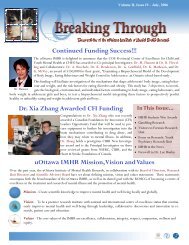Catatonia as a psychomotor syndrome: A rating scale ... - The Royal
Catatonia as a psychomotor syndrome: A rating scale ... - The Royal
Catatonia as a psychomotor syndrome: A rating scale ... - The Royal
You also want an ePaper? Increase the reach of your titles
YUMPU automatically turns print PDFs into web optimized ePapers that Google loves.
CATATONIA AND EXTRAPYRMIDAL MOTOR SYMPTOMS 413<br />
relatively independent of the underlying comorbid dise<strong>as</strong>e,<br />
for example, schizophrenic or affective psychosis.<br />
One may nevertheless criticize the approach of the present<br />
study <strong>as</strong> circular because several of the symptoms,<br />
<strong>as</strong> applied in the entry criteria by Rosebush, also appear<br />
in the <strong>scale</strong> which is being validated. However, entry<br />
criteria and criteria in the <strong>scale</strong> for validation are not<br />
similar because the former does not include affective<br />
alterations and extrapyramidal hyperkinesi<strong>as</strong> and does<br />
not distinguish between the different categories of symptoms.<br />
Consequently, the NCS with its three sub<strong>scale</strong>s<br />
does not replicate clinical entry criteria so that validity of<br />
the NCS is not self-evident or superfluous.<br />
<strong>The</strong> sample investigated in the present study encomp<strong>as</strong>ses<br />
only acute catatonic patients, where<strong>as</strong> those with<br />
chronic or organic catatonia were not considered. A recent<br />
study 30 could find no major differences in catatonic<br />
symptomatology, <strong>as</strong> me<strong>as</strong>ured with BFCRS, between<br />
acute and chronic catatonic patients. However, because<br />
the BFCRS does not contain many affective items (see<br />
above), our results in acute catatonic patients, obtained<br />
with the NCS, should not be automatically transferred to<br />
chronic patients.<br />
<strong>Catatonia</strong>, Hyperkinesi<strong>as</strong>, and Neuroleptics<br />
In the pre-neuroleptic era, Kahlbaum 1 and other authors<br />
2,27,32–37 described extrapyramidal hyperkinesia<br />
such <strong>as</strong> choreatic- and athethotic-like movements <strong>as</strong> well<br />
<strong>as</strong> dyskinesi<strong>as</strong> in catatonic patients. After the introduction<br />
of psychopharmacologic drugs, such movements<br />
have been generally <strong>as</strong>sociated with neuroleptics rather<br />
than with catatonia itself. 29 However, recent studies<br />
showed a close <strong>as</strong>sociation between dyskinesi<strong>as</strong> and<br />
catatonia 10,21,28,30 which would be supported by the following<br />
results in the present study: (1) AIMS scores<br />
significantly correlated with catatonia scores (NCS total<br />
score, NCS motor subscore, BFCRS, MRSc, MRSs,<br />
Rosebush) only on days 0 and 1 (see Table 5) but not on<br />
the other days (3, 7, and 21) when most patients were<br />
being treated with neuroleptics; (2) neuroleptically untreated<br />
catatonic patients showed significantly higher<br />
AIMS scores on day 0 than neuroleptically treated catatonics<br />
(see Table 5); (3) neuroleptically untreated catatonic<br />
patients showed significantly higher AIMS scores<br />
on day 0 than neuroleptically untreated psychiatric control<br />
subjects; and (4) NCS scores (NCS total, NCS motor)<br />
significantly correlated with MRSs, the only <strong>scale</strong><br />
that also included extrapyramidal hyperkinesi<strong>as</strong>. Consequently,<br />
our results point out the close relationship between<br />
catatonia and extrapyramidal hyperkinesi<strong>as</strong>, the<br />
latter not being explained by previous neuroleptic medication,<br />
that is, the occurrence of dyskinesi<strong>as</strong> in catatonia<br />
seems to be relatively independent of psychopharmacologic<br />
treatment. However, whether one <strong>as</strong>sumes a coexistence<br />
of catatonia and dyskinesia, <strong>as</strong> is postulated<br />
by Bush, 30 or whether one considers dyskinesi<strong>as</strong> <strong>as</strong> part<br />
of catatonic symptomatology h<strong>as</strong> to remain an open<br />
question.<br />
Furthermore, our results show that catatonic symptomatology<br />
in general is not strongly influenced by previous<br />
neuroleptic medication. We could not find any significant<br />
differences in symptomatic profiles (see Results) or<br />
in catatonic scores between neuroleptically untreated and<br />
treated catatonic patients on day 0. Furthermore, although<br />
neuroleptic premedication w<strong>as</strong> matched between<br />
groups, catatonic patients nevertheless showed significantly<br />
higher AIMS and SEPS scores than psychiatric<br />
control subjects on day 0. Consequently, expression and<br />
manifestation of catatonic symptoms seems to be more<br />
or less independent of previous neuroleptic medication.<br />
Neuroleptically treated catatonic patients showed significantly<br />
lower AIMS scores than neuroleptically untreated<br />
catatonic patients on day 0, where<strong>as</strong> hypokinesi<strong>as</strong>, <strong>as</strong><br />
me<strong>as</strong>ured with SEPS, did not differ significantly between<br />
both subgroups. Neuroleptics may initially suppress<br />
dyskinesi<strong>as</strong> which would explain lower AIMS scores in<br />
neuroleptically treated catatonic patients on day 0 (see<br />
Table 5).<br />
APPENDIX<br />
Northoff <strong>Catatonia</strong> Scale<br />
Patient:<br />
ID:<br />
Date:<br />
Rater:<br />
Quantification: applying to each item respectively<br />
0 abnormality absent<br />
1 abnormality definitely present, but moderately<br />
and occ<strong>as</strong>ionally present with possibility of interruptions<br />
2 abnormality constantly and severely present without<br />
any possibility of interruption<br />
Diagnosis of catatonic <strong>syndrome</strong>: at le<strong>as</strong>t one symptom<br />
from each category (motor, affective, behavioral)<br />
independent from underlying comorbid dise<strong>as</strong>e<br />
I. Motor Alterations<br />
1. Mannerisms<br />
Odd, bizarre, artificial execution of purposeful movements<br />
with a disturbance in the harmony of movements.<br />
2. Stereotypy<br />
Repetitive (>3), non-goal-directed movements with<br />
unchanged character during the frequent repetitions.<br />
3. Festination<br />
Uncoordinated, inappropriate, jerky-like, h<strong>as</strong>ty move-<br />
Movement Disorders, Vol. 14, No. 3, 1999
















